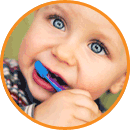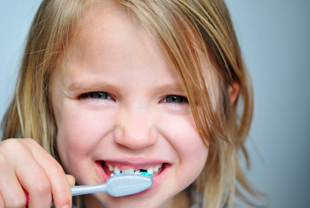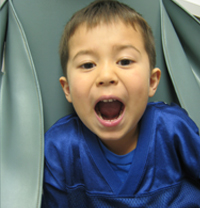How can I prevent injuries to my child's teeth?
- If you have toddlers, make sure your house is childproof.
- Pad sharp corners or protruding knobs and handles on furniture
- When your child is in a stroller or car, make sure she is strapped in firmly. Never let your child stand on a seat or sit in your lap while you are in a car.
- Mouthguards can prevent injuries in older children. Most dental injuries occur in your neighborhood, not on the gym floor or playing field, so a mouthguard should ideally be worn during all rough play, even if it’s just in your own backyard.
What should I do if my child has a toothache?
Often, children who complain of a toothache often have food lodged between their teeth. Gently flossing the area of discomfort may provide immediate relief. If it is something more serious:
- Call your dentist immediately.
- Until your child can be treated, rinse their mouth with lukewarm water and apply cloth-wrapped ice to their face.
- Do not apply heat.
- Never put an aspirin on the tooth or gums. Aspirin is acidic, and if placed on a tooth or against the gums, it can produce burns. If you’re going to use aspirin, make sure it’s swallowed.
What should I do if my child’s front permanent tooth gets knocked out?
- Your child must see a dentist within one hour of the incident. If you wait any longer, the chances of the tooth being successfully re-implanted are poor.
- If you can, rinse it in cool water; don’t wipe it or scrub it.
- Place it in a glass of water or milk, or gently wrap it in a clean, damp cloth until you get to your dentist’s office.
- Teeth that have been knocked out will almost always require a root canal, but they can often survive for years if treated within one hour after the injury.
- To protect your child in the future, have your dentist fit your child for a mouthguard.
My child fell and bumped their front baby tooth and now it's dark. Is it dead?
Probably. The discoloration may mean that the impact has broken a blood vessel at the tip of the tooth’s root. Here is one note of encouragement: Baby teeth often survive blows that would kill a permanent tooth. Take your child to a dentist right away and have the tooth examined.
My child chipped their front tooth. How difficult will it be to fix it, and how long will it take?
If you find the fragment, bring it with you to the dental office. A fragment can occasionally be bonded back onto the tooth. Even without the broken piece, a dentist can often restore the tooth to its natural appearance in less than one hour.
My child just had a bad fall and bumped their teeth. What should I do?
You can expect the following reactions:
- Change in colour of the tooth

tooth discoloration
- The tooth (teeth) will probably darken over a period of time, eventually turning quite dark. Usually, the colour will be a charcoal gray, although it may be brown, yellow or a lighter colour. This will begin to lighten again, returning to a colour similar to how the tooth appeared before the injury, but not quite as snow white.
- Looseness
- The bone that supports the tooth has been expanded by the injury, which will make the tooth looser than normal. As the bone returns to the normal position, the tooth will also tighten up again.
- 3. Bleeding and swelling
- As with any injury, the normal reaction of the injured tissues (in this case, the gums and/or lips) will bleed and/or swell. A warm pack (a washcloth is good) will help decrease the swelling and a warm salt water rinse will promote healing of any cuts.
- 4. Pain
- Fortunately, children do not usually suffer much pain from injuries to teeth. Occasionally there will be pain if the child tries to chew with the injured tooth. As with any injury, the area should be ‘babied’ to avoid aggravating the injury.
You should watch for any of the following:
- Change in any eating or sleeping habits
- If your child’s normal eating habits change, (in particular if he or she complains when chewing or drinking something cold) or if your child is not sleeping, another check-up is appropriate.
- Gum Boils

a gum boil
- This will appear on the gums in the area where the gums and lips meet. Gum boils look like a small blister or pimple on the gums.
- Increased swelling, looseness or pain
- If any of the ‘expected reactions’ become worse, the area should be re-examined.
IF IN DOUBT, DO NOT HESITATE TO CALL THE OFFICE ABOUT YOUR CHILD
To download this information in PDF form, click here.
What should I do if the wire or brackets for braces break?
There are a few things you can do to minimize the discomfort of orthodontic wire protruding from your teeth. Ideally, cover the sharp end with a small piece of dental wax; orthodontists will provide this material for you. If you don’t have any wax, you can use a little chunk of pre-chewed sugarless gum. Call your orthodontist or dentist to have the bracket re-cemented or the wire clipped and trimmed.











